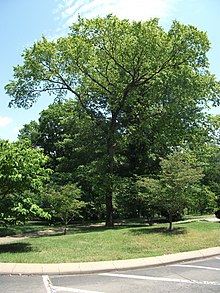Ulmus serotina, the September elm, is an autumn-flowering North American species of tree. It is uncommon beyond Tennessee; it is only very locally distributed through Illinois, Kentucky, Arkansas, Mississippi, Oklahoma, Alabama, and Georgia, and disjunct populations into Nuevo León, Mexico.[2] It grows predominantly on limestone bluffs and along streams to elevations of 400 m.[3]
| Ulmus serotina | |
|---|---|

| |
| Ulmus serotina, Cheekwood, Nashville, TN | |
| Scientific classification | |
| Kingdom: | Plantae |
| Clade: | Tracheophytes |
| Clade: | Angiosperms |
| Clade: | Eudicots |
| Clade: | Rosids |
| Order: | Rosales |
| Family: | Ulmaceae |
| Genus: | Ulmus |
| Subgenus: | U. subg. Oreoptelea |
| Section: | U. sect. Chaetoptelea |
| Species: | U. serotina
|
| Binomial name | |
| Ulmus serotina | |

| |
| Generalized natural range of Ulmus serotina in the US | |
| Synonyms | |
| |
Description
editRarely exceeding 20 m in height, the tree has a rounded crown with spreading to pendulous branches. The glabrous young shoots become progressively corky-winged with age, and bear oblong to obovate leaves <8 cm long.[4] The wind-pollinated apetalous perfect flowers form pendulous racemes, which open in September and serve to distinguish the species from its cogenitor, the cedar elm U. crassifolia, with which it readily hybridizes. The samarae are oblong-elliptical, 10–15 mm in length, deeply divided at the apex, and ripen in November.[5]
-
U. serotina bark
-
Bole of same
-
U. serotina foliage
-
U. serotina in fruit
-
September elm in October, Elmwood Cemetery, Memphis, Tennessee (2010)
Pests and diseases
editThe species is highly susceptible to Dutch elm disease.
Cultivation
editBefore the outbreak of Dutch elm disease, U. serotina enjoyed limited popularity as a shade tree in the southern part of its range. The tree grows well on most soils, but is intolerant of anaerobic or saline conditions; it is also frost tolerant to -30°C (-23°F). The September elm is very rare in cultivation in Europe;[6] it was briefly propagated and marketed in the UK by the Hillier and Sons nursery, Winchester, Hampshire, from 1972 to 1977, when 16 were sold.[7][8] It is not known to have been introduced to Australasia. No cultivars of this taxon are known, nor is it known to be in commerce.
Notable trees
edit- The current US national champion, measuring 28.65 meters high in 2013, grows in the Spring Grove Cemetery in Hamilton County, Ohio.[9][10]
- The former national champion measured at 25.5 m high in 2007, grows in Davidson County, Tennessee.[11][12]
Hybrids
editAccessions
edit- North America
- Mildred E. Mathias Botanical Garden, UCLA, Los Angeles, California, US. (No details available)
- Morton Arboretum, US. Acc. no. 1039-23.
- U S National Arboretum [1][permanent dead link], Washington, D.C., US. Acc. no. 55431.
- Europe
- Grange Farm Arboretum, Sutton St James, Spalding, Lincolnshire, UK. Acc. no. not known.
- Royal Botanic Garden Edinburgh, UK. Acc. no. 20080091, from seed wild collected in USA.[20]
- Royal Botanic Gardens, Kew, UK. Acc. no. not known.
- Royal Botanic Gardens, Wakehurst Place, UK. Acc. no. 2006-143.
- Sir Harold Hillier Gardens, UK. Acc. no. 2004.1059, 3 trees, collected in Tennessee, 2004.
- Thenford House arboretum, Banbury, UK. No details available.
- University of Copenhagen, Botanic Garden, Denmark. No details available.
References
edit- ^ IUCN SSC Global Tree Specialist Group.; Botanic Gardens Conservation International; et al. (BGCI) (2020). "Ulmus serotina". IUCN Red List of Threatened Species. 2020: e.T152858625A152905642. doi:10.2305/IUCN.UK.2020-1.RLTS.T152858625A152905642.en. Retrieved 19 November 2021.
- ^ Todzia, C. A.; Panero, J. L. (1998), "A new species of Ulmus (Ulmaceae) from southern Mexico and a synopsis of the species in Mexico", Brittonia, 50 (3): 343–347, Bibcode:1998Britt..50..343T, doi:10.2307/2807778, JSTOR 2807778, S2CID 21320752
- ^ Duncan, W. H., & Duncan, M. B. (2000). Trees of the Southeastern United States, 234–238. Athens, Georgia, USA. ISBN 0-8203-2271-7
- ^ "Ulmus serotina Sarg.". Herbarium catalogue. Board of Trustees of the Royal Botanic Gardens, Kew. Retrieved 17 October 2016.
- ^ NRCS. "Ulmus serotina". PLANTS Database. United States Department of Agriculture (USDA).
- ^ Bean, W. J. (1981). Trees and shrubs hardy in Great Britain, 7th edition. Murray, London.
- ^ Hillier & Sons (1977). Catalogue of Trees & Shrubs. Hillier, Ampfield, UK.
- ^ Hillier & Sons Sales inventory 1962 to 1977 (unpublished).
- ^ "September Elm - OH". American Forests. Retrieved 2023-10-03.
- ^ "Spring Grove Cemetery - Champions of the Grove". Spring Grove Cemetery.
- ^ "Ghost Trees: The champion September elm". Vanderbilt University. Retrieved 2023-10-03.
- ^ "National Champion Trees".
- ^ "Ulmus serotina in Flora of North America @ efloras.org". www.efloras.org. Retrieved 2024-12-09.
- ^ "Duke University Vascular Plant Collection (DUKE)". vplants.org. Retrieved 2024-12-09.
- ^ "Louisiana State University, Shirley C. Tucker Herbarium (NO:Vascular Plants)". vplants.org. Retrieved 2024-12-09.
- ^ "Mississippi Museum of Natural Science Herbarium (MMNS)". vplants.org. Retrieved 2024-12-09.
- ^ "Mississippi State University (MISSA)". vplants.org. Retrieved 2024-12-09.
- ^ "Arkansas Natural Heritage Commission Herbarium (ANHC)". vplants.org. Retrieved 2024-12-09.
- ^ "Austin Peay State University Herbarium (APSC)". vplants.org. Retrieved 2024-12-09.
- ^ "Royal Botanic Garden Edinburgh - Catalogue of the Living Collections". data.rbge.org.uk. Retrieved 2024-12-09.
